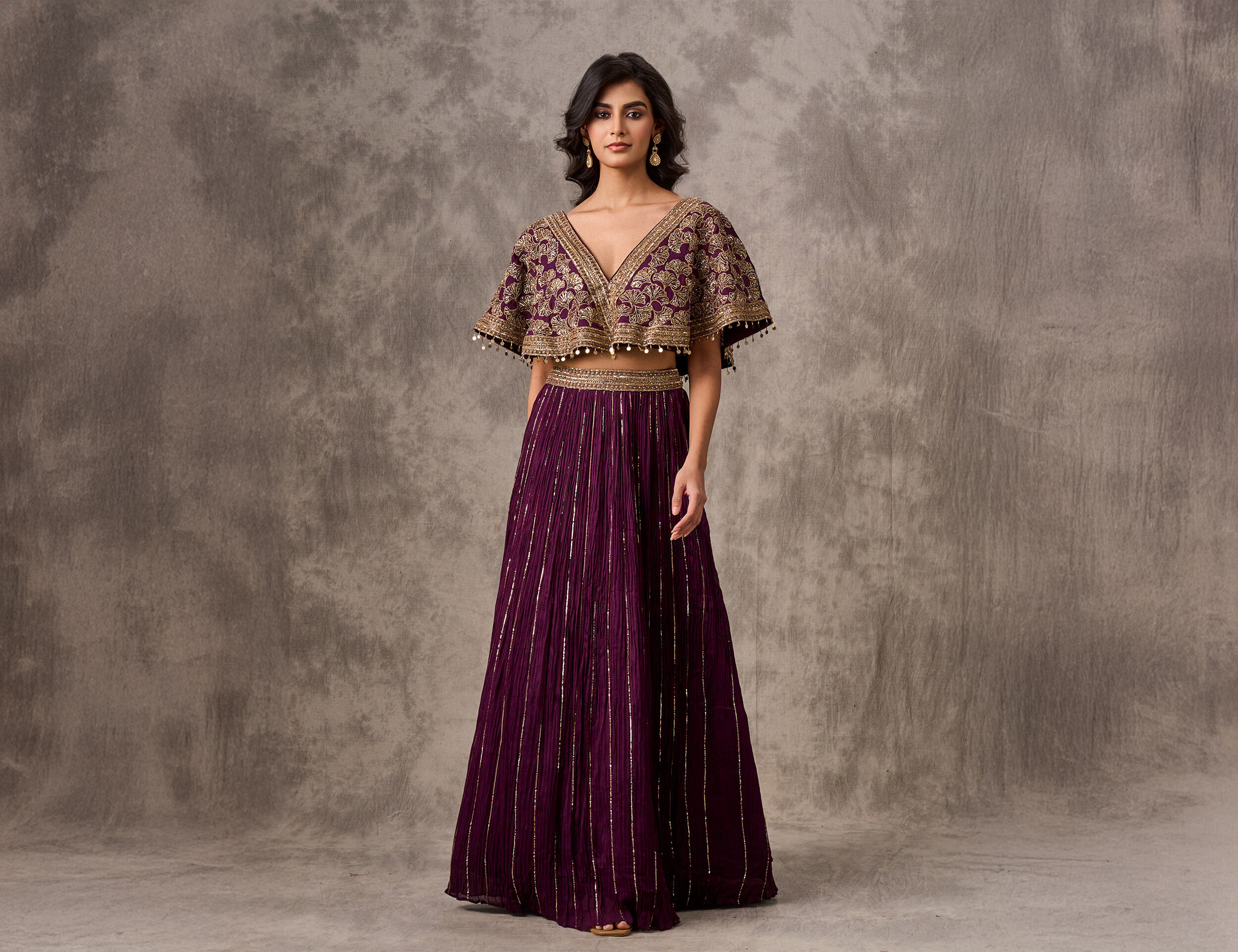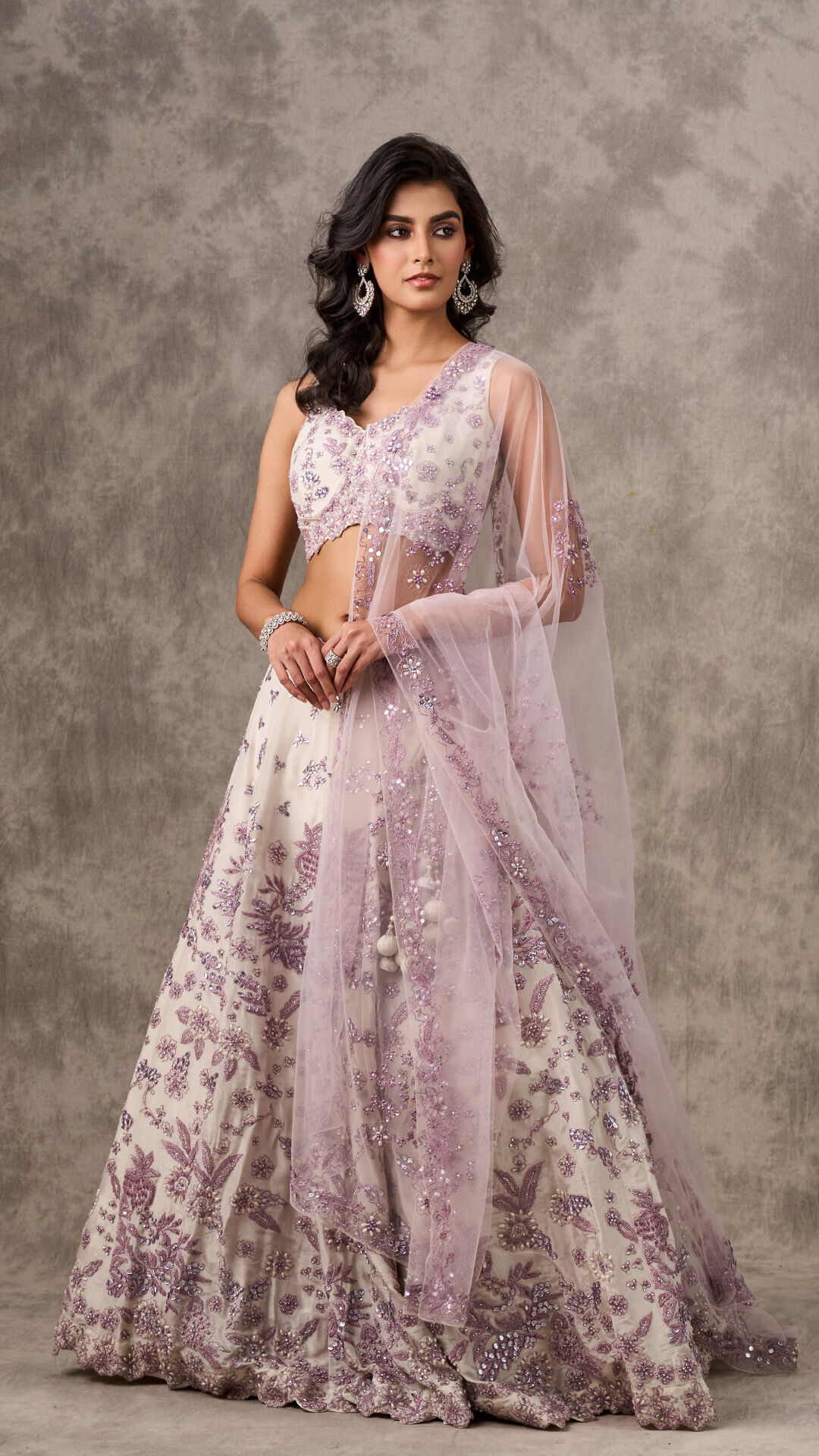STORIES BY TWAMEV

Lifestyle
Difference Between a Ghagra and a Lehenga: Choosing the Perfect Bridal Skirt
Date 31 October 2025 | Reading time: 7-10 mins
Within India's magnificent tapestry of ceremonial dress, two silhouettes command reverence for their timeless grace and cultural significance: the ghagra and the lehenga. These celebrated skirts, rooted in centuries of tradition yet perpetually reinvented, remain essential for every celebration, from intimate sangeets to lavish wedding receptions.
But what is the difference between ghagra and lehenga? Though they might seem interchangeable to casual observers, their distinctive construction, embellishment techniques, and ceremonial roles reveal fascinating contrasts.
This exploration unveils the subtle difference between ghagra and lehenga, whilst introducing their lesser-known relative, the lacha, and illuminating the contemporary trends reshaping their enduring appeal.
Understanding the Basics: Ghagra, Lehenga, and Lacha
Have you ever paused to consider how these celebrated silhouettes diverge despite their shared heritage? Let's unravel the differences between a ghagra, a lehenga, and a lacha.
What is Ghagra?
The ghagra pulses with the vivacious spirit of India's folk traditions, particularly those flourishing in Gujarat and Rajasthan's sun-drenched landscapes. Distinguished by its abundantly gathered skirt that cascades from the waist in fluid waves, the ghagra champions comfort and uninhibited movement.
Artisans craft these pieces from breathable cottons, gossamer chiffons, or lustrous silks, embellishing them with regional treasures: intricate mirror work that catches candlelight, vibrant bandhani patterns, or bold block prints.
Usually styled with an elongated blouse or kurti and flowing dupatta, the ghagra suits cultural festivities like Navratri garba nights or relaxed family celebrations, radiating an effortless, spirited elegance.
What is a Lehenga?
The lehenga, conversely, embodies pure magnificence, serving as the cornerstone of bridal wardrobes and grand occasions. A lehenga for women comprises three essential elements: an intricately embellished choli that sculpts the torso, a dramatically flared skirt, and an ethereal dupatta.
Unlike the ghagra's relaxed gathering, lehengas feature precise tailoring that nips the waist before cascading into a sweeping A-line silhouette. Master craftsmen work with sumptuous silks, plush velvets, or shimmering brocades, adorning each piece with painstaking zardozi, glittering sequins, or intricately delicate motiwork, establishing them as the ultimate choice for nuptials and prestigious gatherings.
What is Lacha?
The lacha, frequently mistaken for its lehenga cousin, represents a distinctive tradition rooted in North India's cultural heartland, particularly Punjab. This ensemble features a richly embroidered skirt, fitted choli, and notably voluminous dupatta, often showcasing masterful phulkari needlework or gleaming gota patti embellishments.
The lacha's skirt shares similarities with the lehenga yet maintains a more relaxed fit, whilst its dupatta takes centre stage through elaborate draping techniques, honouring its ceremonial importance in Punjabi matrimonial celebrations and harvest festivals.
Key Differences between Ghagra and Lehenga
Comprehending the difference between ghagra and lehenga demands examining their construction methods, ceremonial applications, and regional heritage.
Design and Structure
The difference between ghagra and lehenga becomes immediately apparent through their silhouettes. Ghagras feature a gentle gathering at the waistband, creating an unstructured, billowing form that prioritises ease of wear. These pieces often showcase restrained ornamentation or regional techniques like tie-dye bandhani or reflective mirror work.
Lehengas, however, employ architectural precision to emphasise the waistline, expanding into calculated A-line or circular flares. Their foundation fabrics—crisp silks, sumptuous velvets, or ethereal organzas—provide stable canvases for elaborate embroidery, transforming them into wearable art.
Usage and Occasions
Ghagras excel in relaxed or semi-formal environments: folk dance performances, regional celebrations, or intimate family functions. Their lightweight nature ensures daylong comfort. Lehengas command attention at formal gatherings, particularly matrimonial ceremonies.
Regional Variations
The difference between ghagra and lehenga extends to their geographical identities. Ghagras remain intrinsically linked to Gujarat and Rajasthan, showcasing indigenous crafts like bandhani dyeing or metallic gota patti.
Lehengas, whilst embraced nationwide, maintain strong associations with North Indian wedding traditions, manifesting in regional interpretations like Uttar Pradesh's opulent Banarasi lehengas or Delhi's couture embroidered creations.
Difference between Lacha and Lehenga
The lacha, though less frequently discussed, enriches the difference between ghagra and lehenga dialogue, sharing lehenga characteristics whilst maintaining distinct features.
Design and Structure
Both lacha and lehenga incorporate flared skirts, yet the lacha's construction favours a more relaxed silhouette, permitting graceful movement. The lacha's signature element remains its dupatta, often heavily embellished and draped with ceremonial grandeur across the shoulders or head.
Lehengas emphasise waist definition and structured flaring, treating the dupatta as an elegant accompaniment rather than the primary focus.
Usage and Occasions
Lachas dominate Punjabi matrimonial celebrations and cultural observances like Lohri, where their exuberant embroidery and dramatic dupattas amplify festive energy. Lehengas demonstrate greater versatility, gracing weddings throughout India and prestigious events.
A maroon lehenga for women, for instance, creates timeless bridal or reception elegance, whilst lachas remain anchored to specific cultures.
Regional Variations
The lacha embodies Punjab's textile heritage, featuring distinctive phulkari embroidery or shimmering gota patti that reflects regional artistry. Lehengas, though originating in North India, have transcended boundaries, spawning variations like Rajasthan's lehenga choli or South India's silk interpretations.
Latest Trends and Inspirations
The difference between ghagra and lehenga manifests in their contemporary evolution, as designers reimagine these classics for modern sensibilities.
Trends in Ghagra
- Pastel Palette: Delicate shades, including lavender, blush peach, and seafoam mint, are revolutionising ghagras, perfectly suited for sunlit mehendi ceremonies or intimate sangeets. These gentle hues, enhanced with subtle mirror work, project refined sophistication.
- Sustainable Fabrics: Environmentally conscious ghagras fashioned from organic cotton or handwoven khadi attract discerning buyers. These pieces, featuring natural vegetable dyes and classic prints, champion sustainability whilst maintaining impeccable style.
- Mix-and-Match Prints: Contemporary florals, geometric designs, or abstract patterns transform ghagras into spirited, modern statements. Balance a patterned ghagra with a solid-coloured blouse for harmonious yet eye-catching appeal.
Trends in Lehenga
- Ombre Elegance: An attractive gradient lehenga, flowing from whisper-soft pastels to rich jewel tones, creates mesmerising visual poetry. These skirts, complemented by meticulously embroidered cholis, satisfy brides seeking contemporary luxury.
- 3D Florals: Dimensional floral appliqués and raised 3D sequins dominate current lehenga aesthetics, introducing romantic whimsy. A pink lehenga for the bride adorned with botanical embroidery becomes an enchanting choice for spring celebrations.
- Metallic Sheen: Gilded, silver, and bronze lehengas capture attention, embellished with sequins or classic zari for imperial impact. These luminous creations require minimal jewellery to achieve maximum effect.
Trends in Lacha
- Phulkari Revival: Contemporary lachas celebrate vibrant phulkari artistry, featuring bold geometric motifs in striking colour combinations like crimson and gold, ideal for Punjabi matrimonial ceremonies.
- Gota Patti Glam: Metallic gota patti embellishment elevates modern lachas, introducing celebratory shimmer perfect for wedding festivities and sangeet performances.
- Layered Dupattas: Innovative lachas experiment with multiple dupatta layers, arranged dramatically to create voluminous, sculptural silhouettes that command attention.
Enduring Styles that Define Every Celebration
The difference between ghagra and lehenga, alongside their relative, the lacha, reveals itself through construction techniques, cultural importance, and contemporary interpretations. As fashion evolves, these garments continue to enchant with soft colour palettes, sustainable materials, and innovative embellishments. Whether you gravitate towards a ghagra's relaxed allure, the magnificence of a red lehenga for the bride, or a lacha's cultural authenticity, select pieces that reflect your personal aesthetic.
Explore Twamev's curated selections to discover an ensemble that feels Truly You, allowing these enduring silhouettes to elevate your celebrations.




